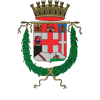The crypt reveals the archaic foundation of the church of Santa Sofia: alongside the discovery of Roman remains, there is a sacrificial stone from a pagan temple probably dedicated to Mithras, a deity of Persian origin whose earliest traces date back to 1300 BC.
The first major renovation of the church dates back to the 9th century, during the Carolingian era; the current building was erected between 1106 and 1127 starting from the apse area.
The external wall surface enhances the brickwork and its chromatic shades, showcasing the extraordinary skill of the craftsmen who made the bricks.
The three internal naves are separated by pillars and Byzantine columns that are each different from one another. The remains of the oldest wall decoration, dating back to the 13th century, are now deteriorated: in the lunette of the apse, a fragment of fresco depicting the Madonna with child and two saints of Giotto’s school is visible.
Thanks to the accurate notes of chroniclers from past centuries, we know that in 1448, seventeen-year-old Andrea Mantegna signed his first altarpiece and that at such a young age he was already referred to as “magister” and “pictor”. Of this lost work, which adorned the main altar of the church of Santa Sofia, only the transcription of the epigraph with which it was adorned remains, through which we learn that Mantegna was born in 1431 in Isola di Carturo, on the border between Vicenza and Padua.












